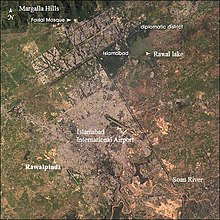| Zones in Islamabad | ||
|---|---|---|
| Zone | Area | |
| acres | km2 | |
| | ||
| I | 54,958.25 | 222.4081 |
| II | 9,804.92 | 39.6791 |
| III | 50,393.01 | 203.9333 |
| IV | 69,814.35 | 282.5287 |
| V | 39,029.45 | 157.9466 |
| | ||
| Source: | Lahore Real Estate | |
The main administrative authority of the city is Islamabad Capital Territory Administration (ICT) with some help from Capital Development Authority (CDA) which oversees the planning, development, construction, and administration of the city.
Islamabad Capital Territory is divided into eight zones: Administrative Zone, Commercial District, Educational Sector, Industrial Sector, Diplomatic Enclave, Residential Areas, Rural Areas and Green Area. Islamabad city is divided into five major zones: Zone I, Zone II, Zone III, Zone IV, and Zone V. Out of these, Zone IV is the largest in area. Zone I consists mainly of all the developed residential sectors while Zone II consists of the under-developed residential sectors. Each residential sector is identified by a letter of the alphabet and a number, and covers an area of approximately 2 km × 2 km (1 1⁄4 mi × 1 1⁄4 mi). The sectors are lettered from A to I, and each sector is divided into four numbered sub-sectors.
Series A, B, and C are still underdeveloped. The D series has seven sectors (D-11 to D-17), of which only sector D-12 is completely developed. This series is located at the foot of Margalla Hills.The E Sectors are named from E-7 to E-17.Many foreigners and diplomatic personnel are housed in these sectors.In the revised Master Plan of the city, CDA has decided to develop a park on the pattern of Fatima Jinnah Park in sector E-14. Sectors E-8 and E-9 contain the campuses of three Defense universities: Bahria University, Air University, and the National Defence University.
The F and G series contains the most developed sectors. F series contains sectors F-5 to F-17; some sectors are still under-developed. F-5 is an important sector for the software industry in Islamabad, as the two software technology parks are located here. The entire F-9 sector is covered with Fatima Jinnah Park. The Centaurus complex will be one of the major landmarks of the F-8 sector.G sectors are numbered G-5 through G-17.Some important places include the Jinnah Convention Center and Serena Hotel in G-5, the Red Mosque in G-6, and the Pakistan Institute of Medical Sciences, the largest medical complex in the capital, located in G-8.
The H sectors are numbered H-8 through H-17.The H sectors are mostly dedicated to educational and health institutions. National University of Sciences and Technology covers a major portion of sector H-12. The I sectors are numbered from I-8 to I-18. With the exception of I-8, which is a well developed residential area, these sectors are primarily part of the industrial zone. Currently two sub-sectors of I-9 and one sub-sector of I-10 are used as industrial areas. CDA is planning to set up Islamabad Railway Station in Sector I-18 and Industrial City in sector I-17.
Zone III consists primarily of the Margalla Hills and Margalla Hills National Park. Rawal Lake is in this zone. Zone IV and V consist of Islamabad Park, and rural areas of the city. The Soan River flows into the city through Zone V.
Islamabad/Rawalpindi Metropolitan Area
See also: List of places in Islamabad
When the master plan for Islamabad was drawn up in 1960, Islamabad and Rawalpindi, along with the adjoining areas, would be integrated to form a large metropolitan area called Islamabad/Rawalpindi Metropolitan Area. The area would consist of the developing Islamabad, the old colonial, cantonement city of Rawalpindi, and Margalla Hills National Park, including surrounding rural areas. The three combined areas are now called Islamabad Capital Territory.Initially, it was proposed that the three areas would be connected by four major highways: Murree Highway, Islamabad Highway, Soan Highway, and Capital Highway. However, to date only two highways have been constructed: Kashmir Highway (the former Murree Highway) and Islamabad Highway. Islamabad is the hub all the governmental activities while Rawalpindi is the centre of all industrial, commercial, and military activities. The two cities are considered sister cities and are highly interdependent.


No comments:
Post a Comment